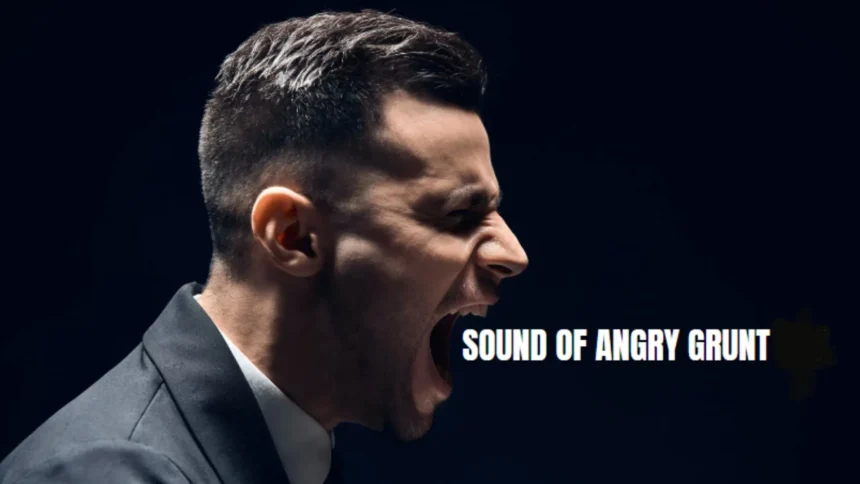Have you ever heard the sound of an angry grunt? It’s a primal expression, raw and unfiltered. This guttural noise can convey frustration, strength, or even triumph. From athletes pushing through intense workouts to someone venting their anger after a tough day, grunting has become an intriguing aspect of human behavior.
We often overlook the significance behind this simple yet powerful sound of an angry grunt. What does it mean when we grunt? How did this vocalization evolve over time? And why do some people embrace it while others shy away from making such noise?
Join us on a journey of the sound of an angry grunt as we explore the rich history of grunting, its scientific underpinnings, and its emotional connections. Let’s dive deep into understanding the sound of an angry grunt and what it reveals about our very humanity.
The History of Grunting: From Cave People to Modern Athletes
Grunting has roots that stretch back to our earliest ancestors. Cave people communicated through sounds, and grunts were an efficient way to express emotions or alert others of danger. These primal noises fostered a sense of community and connection.
As humanity evolved, so did the meaning behind grunting. In ancient cultures, warriors used guttural sounds during battle to intimidate opponents and rally their comrades. The sheer force of these expressions often accompanied physical exertion or emotional release.
Fast forward to modern times, where athletes have embraced the grunt as part of their performance routines. Whether lifting weights or sprinting on a track, this sound serves as both a motivational tool and an outlet for pent-up energy. It’s fascinating to see how such a simple expression has transcended time while continuing to resonate in various forms across different arenas.
The Science Behind Grunting: Why We Do It and How It Affects Us
Grunting is more than just a sound; it’s a primal expression of emotion. When we grunt, our bodies respond in fascinating ways. The act of grunting can release tension and channel energy, allowing individuals to push through physical challenges.
Neurologically, this vocalization activates certain areas in the brain linked to motor control. The sound of an angry grunt enhances performance by increasing air pressure, which supports muscular exertion during activities like lifting weights or sprinting.
Moreover, grunting releases adrenaline and endorphins into the bloodstream. These hormones contribute to feelings of strength and resilience.
Interestingly, studies show that grunting can help alleviate pain perception as well. By voicing discomfort or frustration, we may inadvertently lessen its impact on our psyche.
In essence, the sound of an angry grunt serves not only as an emotional outlet but also as a tool for enhancing physical capacity and managing pain responses effectively.
The Controversy Surrounding Grunting in Sports
Grunting in sports often sparks heated debates. Some athletes argue it enhances performance, helping them channel energy into their movements. The sound of an angry grunt can signify intensity and determination.
On the flip side, critics claim that grunting disrupts the focus of opponents. In tennis, for instance, some players feel it’s a psychological tactic meant to throw them off their game.
Moreover, noise levels during matches have led to calls for regulations. Spectators sometimes complain about the distraction caused by loud grunts echoing through stadiums.
Coaches also weigh in on this phenomenon. They debate whether teaching athletes to control or embrace their vocal expressions affects overall performance.
What remains clear is that grunting evokes strong emotions and opinions within the sporting community.
The Connection Between Grunting and Raw Emotion
Grunting often transcends mere sound; it’s an expressive outlet for intense feelings. When words fail, a grunt can convey frustration, anger, or even exhilaration.
Our bodies instinctively produce these guttural sounds during moments of high emotion. It’s as if the vocal cords vibrate to release pent-up energy. The sound of an angry grunt resonates with primal instincts rooted deep in human history.
This raw expression connects us to our ancestors who likely communicated similar emotions through grunts and growls. Each grunt carries weight and meaning, tapping into a shared human experience that requires no translation.
In sports or everyday life, grunting serves as both catharsis and connection. It reflects authenticity—a true snapshot of what we feel inside without pretense or polish. This powerful visceral response reminds us that feeling intensely is part of being alive.
Examples of Grunts in Different Scenarios
Grunts can be found in various scenarios, serving as visceral expressions of emotion. In sports, athletes often grunt during intense moments. A tennis player unleashing a powerful serve might let out a fierce sound that echoes across the court. This primal noise not only signifies effort but also adds an element of intensity to the competition.
In everyday life, grunting emerges in moments of frustration or anger. Think about someone stuck in traffic; their annoyed grunt reveals pent-up emotions without needing words. It’s an immediate release—a signal to oneself and others.
Pain is another common trigger for this raw expression. Whether it’s lifting weights at the gym or stubbing a toe on furniture, those guttural sounds are involuntary reactions to discomfort. They provide not just relief but also connect us with others who understand that shared experience of struggle and vulnerability.
Channeling Your Inner Grunt: Using Sound to Release Emotions
Grunting isn’t just a sound; it’s an emotional release. When you feel overwhelmed or frustrated, letting out a grunt can be liberating.
Try this: before tackling that daunting task or facing an uncomfortable situation, take a deep breath and emit your best angry grunt. It might feel silly at first, but the act itself can lighten your mental load.
Sound has power. Grunts resonate with energy that often goes unexpressed in everyday life. By making noise, we tap into our primal selves.
In sports and physical activities, athletes use grunts to channel intensity and focus their minds. You don’t have to be an athlete to harness this technique—anyone can benefit from voicing feelings through sound.
Next time you’re feeling pent-up frustration or raw emotion, let out that guttural growl. Embrace the freedom of expression it brings without judgment or hesitation.
Conclusion: Understanding and Accepting
Understanding the sound of an angry grunt goes beyond mere noise. It is a powerful expression of emotion deeply rooted in human history and biology. From our ancestors who communicated their frustrations through guttural sounds to modern athletes using grunts as tools for performance, this raw form of vocalization serves multiple purposes.
Grunting can be a way to channel anger or pain, providing relief during stressful moments. Athletes harness this energy to enhance focus and power, while others may use it as an outlet for frustration or distress in everyday life. Each grunt tells a story; it reflects what we feel inside when words fail us.
The debate surrounding grunting in sports highlights its significance across various arenas but also reveals societal perceptions about acceptable expressions of emotion. Regardless of context, the connection between these sounds and our feelings cannot be overlooked.
Embracing the sound of an angry grunt allows individuals to tap into their true emotions without fear or shame. By understanding its origins and implications, we learn that such expressions are part of being human—raw, unfiltered, and real.
Accepting the existence of these emotional outbursts might just lead us towards greater self-awareness and authenticity in how we communicate our innermost feelings. The next time you hear that unmistakable sound emerge from within yourself or someone else remember: it’s not just noise; it’s a reflection of humanity’s struggle with emotion itself.










